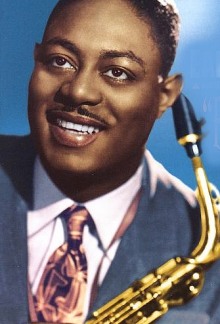As much as I’ve always enjoyed the traditional big band sound of guys like Benny Goodman, Duke Ellington, and Glenn Miller, I’ve also had a certain amount of admiration for those who came along with something a little different. A good example of that would be the bebop revolution of the post-war years, when guys like Dizzy Gillespie and Charlie Parker became stars.
 But another type of jazz pioneer of the era was Earl Bostic, who could make his alto sax soar as smoothly as anyone’s, but sold a lot of records with an aggressive, driving playing style that helped fuel the rise of modern R&B jazz. He also inspired many younger musicians, including John Coltrane.
But another type of jazz pioneer of the era was Earl Bostic, who could make his alto sax soar as smoothly as anyone’s, but sold a lot of records with an aggressive, driving playing style that helped fuel the rise of modern R&B jazz. He also inspired many younger musicians, including John Coltrane.
The Tulsa native first began showing up on bandstands in the early Thirties, working in various groups regionally before eventually tackling the big time by moving to New York. It didn’t take long for him to latch on to some first-class bands, including those of Don Redmon and Lionel Hampton.
During the war years Bostic was much in demand, not only as a musician but as an arranger, and by 1945 he was leading his own band. In the post-war years he reduced his group to a septet and began to generate some records with an evolving style that soon found a ready audience. Fans loved to dance to the throbbing beat and his cranked-up sax, and record sales took off. His first big seller was “Temptation,” and it was followed over the next few years by many others that included his biggest seller, “Flamingo.”
Bostic led several different groups throughout the decade of the Fifties, and provided valuable experience for a lot of young stars, including not only Trane but also Benny Golson and others. Unfortunately, Bostic’s health was beginning to suffer and as the decade came to a close he suffered a heart attack, which stalled the musical side of things for a while. During the last few years of his life he did begin to play occasionally, but spent a lot of his time arranging and also running a small club he’d opened. He died in 1965, just 52.
Iam constantly amazed at how young some of the musicians were. They sure made a mark young
LikeLike
The photo shown on this page is not Earl Bostic. It’s a photo of Bull Moose Jackson.
LikeLike
Note that Jackson is playing his *tenor* saxophone in the photo. Bostic of course played alto.
LikeLike
You are exactly right. Funny that this has been wrong for seven years! 🙂

I’ve now replaced the original picture with one of Earl. But in my defense, it appears that the error actually started with the record company. As you can see below, Bullmoose appears on both his own and Earl’s record jackets. (Of course, I still should have caught the differently sized saxes.)
LikeLike
See more information regarding the great Earl Bostic at a website dedicated to him. http://earlbostic.com/
LikeLike